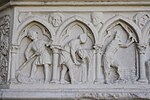St-Éliphe (Rampillon)
The Catholic parish church of Saint-Eliphe in Rampillon , a parish in the Seine-et-Marne department in the French region of Île-de-France , was built in the first half of the 13th century in the Gothic style. The elaborately designed west portal , which is equipped with figurines of vestments , archivolts and a tympanum , dates from the middle of the 13th century . In 1846 the church was added to the list of architectural monuments in France as Monument historique .
history
At the beginning of the 13th century, the town of Rampillon came into the possession of the Order of St. John . The knights of the order probably built the present church on the site of a previous building from the early 12th century, which was consecrated to Saint Savinien von Sens , and placed it under the patronage of Saint Eliphius of Rampillon , a 4th century martyr. The construction of the choir began around 1200/10 . In this first phase of construction, the bell tower, the substructure of which dates from around 1180/90, and the last two yokes of the ship were built. The southern side portal was created around 1240, the west portal around 1240/50. The order buildings were destroyed in 1432 during the Hundred Years War . The only remnant is the round tower that connects to the north of the west facade of the church.
architecture
Exterior construction
The church is made of sandstone . The nave and apse are divided by strong buttresses . On the main nave and the side aisles, a cornice runs under the roof approach , which rests on corbels in which grimaces are carved. The bell tower rises above the sixth yoke of the south aisle, the upper floors of which are pierced by high, round arched sound arcades . Both floors are separated from each other by a cornice supported by consoles, some of which still have heads.
West portal
On the west facade is the magnificent main portal, carved from white limestone . The figure of the pillars of Trumea represents St. Eliphius, the patron saint of the church. The robe is decorated with the statues of the Twelve Apostles . The relief panels underneath have the work of the months as their theme, on the outer panels the presentation in the temple is shown on the left and the Adoration of the Magi on the right.
The tympanum is dedicated to the Last Judgment . In the middle, surrounded by angels, Christ is enthroned as the judge of the world and on the lintel the dead rise from their graves. Slightly pointed archivolts, decorated with round bars , foliage and angel figures, arch above the tympanum .
South portal
The tympanum of the south portal represents the Coronation of Mary . It is surrounded by simple, pointed arched archivolts, the outer arch of which rests on corbels that are carved as female heads.
inner space
Saint-Éliphe is a three-aisled basilica with the three-storey wall elevation typical of Gothic architecture. Mighty pillars with pillars support the pointed arch arcades with round bars . Under the windows of the upper aisle runs a triforium with also pointed arches, multi-profiled arcatures supported by slender columns and which also continue over the rear of the west facade. The nave is divided into eight bays . The main and side aisles are covered with ribbed vaults.
On the vault and on the columns and capitals of the triforium, remains of the painting from the 16th century have been preserved.
Furnishing
- In the church two relief panels with scenes of hell and paradise are kept. Century to be dated.
- In the left aisle there is a wall niche grave with a reclining figure who is called Jéhanne de Nangis.
- The sculpture of the Madonna and Child on the altar of the right aisle was commissioned by the Johannites in the 14th century. It is considered the work of a Parisian workshop. The sculptures of St. Eliphius and St. Barbara date from the 15th century.
- The pulpit was created in the second half of the 18th century.
literature
- Jean-Marie Pérouse de Montclos (ed.): Le Guide du Patrimoine. Ile-de-France . 2nd edition, Hachette, Paris 1994, ISBN 2-01-016811-9 , pp. 543-546.
- Georges Poisson (ed.): Dictionnaire des Monuments d'Île de France. Éditions Hervas, Paris 2001, ISBN 2-84334-002-0 , pp. 670-671.
- Le Patrimoine des Communes de la Seine-et-Marne . Volume 2, Flohic Éditions, Paris 2001, ISBN 2-84234-100-7 , pp. 1115-1118.
Web links
- Église Saint-Éliphe Association des amis de l'Église Saint-Éliphe, accessed on December 13, 2013 (German text)
- Église Saint-Eliphe in the Base Mérimée of the French Ministry of Culture (French)
Coordinates: 48 ° 33 '2 " N , 3 ° 3' 58" E











